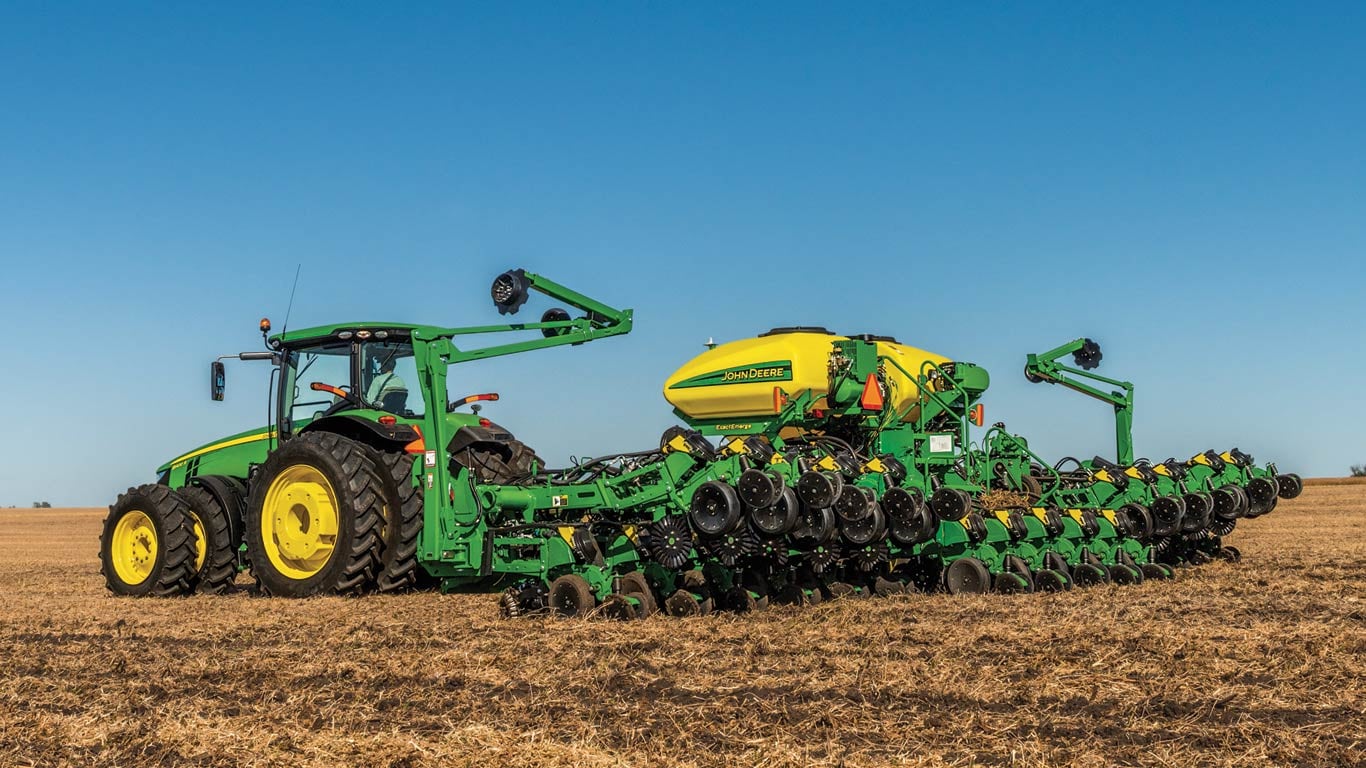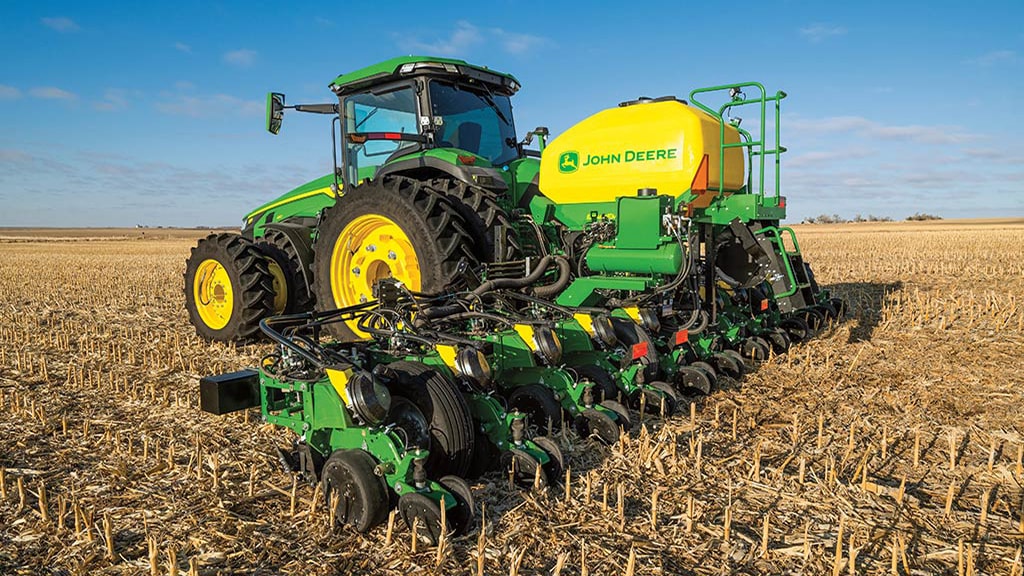Planting Equipment
John Deere offers an entire portfolio that takes every farmer into account — the crop you grow, the topography of your land, the size of your operation, and your budget. Whether you want to replace your planter with a new machine, or upgrade your current planter with new row units, we have the Planting Equipment and Precision Upgrades you need to plant with success.

Drawn Planters
Versatile. Scalable.
Cover more hectares with flexibility and productivity, even in no-till situations.

Integral Planters
Compact. Economical.
These integral planters offer an affordable option for planting in conventional and reduced-till conditions.

DB Planters
Large acres. All-purpose.
Finish the job faster with these hectare-hungry drawn planters. Available in 24 to 54 row configurations.

DR Planters
Customisable. Stack-Fold Technology.
Name your configuration. The Deere-Orthman DR Series mounted planters specialise in flexibility to match those ever-special designs you need.
Compact 1745 Planter
Take the narrow road to better results at harvest. The 1745 Planter is a small, split-row planter that's perfect for smaller fields. Its compact design makes it easy to transport on narrow roads.
Planter Row Units and Performance Upgrade Kits
Pair your planter with the best row unit for your needs to improve seed placement, spacing and emergence.
John Deere ExactEmerge™ Virtual Tour
Accurate at your speed. Whatever that may be. Go deep into the heart of this revolutionary technology and learn what makes ExactEmerge different from any other row unit.
MaxEmerge™ 5 Virtual Tour
See what went into the most versatile row unit on the market in this animated clip.
MaxEmerge™ 5e - Electric Drive Row Unit
This electric drive row unit enables curve compensation and can be ordered with Individual Row Hydraulic Downforce, Pneumatic Closing Wheels and Easy Adjust Row Cleaners.
Weave more productivity into your cotton system
1725C ExactEmerge™ Planter
Drawn Planters
| Models | Number of Rows | Spacing (inches) | Transport Width | Central Commodity System (CCS) | Row Unit |
|---|---|---|---|---|---|
|
8, 16 |
381 mm (15 in.), 762 mm (30 in.) |
3.7 m (12 ft. 2 in.) |
2 x 25 bushels |
MaxEmerge 5 |
|
|
4, 6, 8 |
762 mm (30 in.), 914 mm (36 in.), 965 mm (38 in.) |
4.2 m (13 ft. 10 in.), 4.8 m (15 ft. 8 in.), 7.3 m (24 ft.) |
N/A |
MaxEmerge 5 |
|
|
12 |
762 mm (30 in.) |
4.8 m (15 ft. 8 in.) |
N/A |
MaxEmerge 5 |
|
|
12 |
762 mm (30 in.) |
4.8 m (15 ft. 8 in.) |
N/A |
MaxEmerge 5 |
|
|
12 |
762 mm (30 in.) |
4.6 m (15 ft. 2 in.) |
N/A |
MaxEmerge 5 |
|
|
12 |
762 mm (30 in.) |
3.7 m (12 ft.) |
N/A |
ExactEmerge, MaxEmerge 5e, MaxEmerge 5 |
|
|
16 |
762 mm (30 in.) |
3.7 m (12 ft.) |
N/A |
ExactEmerge, MaxEmerge 5e, MaxEmerge 5 |
|
|
24 |
762 mm (30 in.) |
3.7 m (12 ft.) |
N/A |
ExactEmerge, MaxEmerge 5e, MaxEmerge 5 |
|
|
23 |
762 mm (30 in.)/381 mm (15 in.), 508 mm (20 in.) |
3.7 m (12 ft.), 4 m (12 ft. 11 in.) |
70 bushels; 100 bushels |
ExactEmerge, MaxEmerge 5e, MaxEmerge 5 |
|
|
24 |
762 mm (30 in.)/381 mm (15 in.), 508 mm (20 in.) |
3.7 m (12 ft.), 4 m (12 ft. 11 in.) |
70 bushels; 100 bushels |
ExactEmerge, MaxEmerge 5e, MaxEmerge 5 |
|
|
31 |
762 mm (30 in.)/381 mm (15 in.), 508 mm (20 in.) |
3.7 m (12 ft.), 4 m (12 ft. 11 in.) |
70 bushels; 100 bushels |
ExactEmerge, MaxEmerge 5e, MaxEmerge 5 |
|
|
32 |
762 mm (30 in.)/381 mm (15 in.), 508 mm (20 in.) |
3.7 m (12 ft.), 4 m (12 ft. 11 in.) |
70 bushels; 100 bushels |
ExactEmerge, MaxEmerge 5e, MaxEmerge 5 |
Integral Planters
| Models | Number of Rows | Spacing (inches) | Transport Width | Central Commodity System (CCS) | Row Unit |
|---|---|---|---|---|---|
|
4, 6, 8, 10 |
762 mm (30 in.), 914 mm (36 in.), 965 mm (38 in.), 1,016 mm (40 in.) |
4 m (13 ft. 3 in.), 5 m (16 ft. 4 in.), 7 m (23 ft. 1 in.), 8.8 m (28 ft. 10 in.) |
N/A |
MaxEmerge 5 |
|
|
6 twin rows |
914 mm (36 in.), 965 mm (38 in.) |
4 m (13 ft. 3 in.), 5 m (16 ft. 4 in.), 7 m (23 ft. 1 in.), 8.8 m (28 ft. 10 in.) |
N/A |
MaxEmerge 5 |
|
|
8, 12, 16 |
762 mm (30 in.), 914 mm (36 in.), 965 mm (38 in.), 1,016 mm (40 in.) |
5 m (16 ft. 5 in.), 5.3 m (17 ft. 5 in.), 5.9 m (19 ft. 6 in.), 4.2 m (20 ft. 3 in.), 7.2 m (23 ft. 8 in.), 8.1 m (26 ft. 8 in.) |
N/A |
MaxEmerge 5 |
|
|
16 |
762 mm (30 in.) |
7 m (23 ft. 3 in.) |
100 bushels |
ExactEmerge, MaxEmerge 5e, MaxEmerge 5 |
|
|
12 |
762 mm (30 in.), 914 mm (36 in.), 965 mm (38 in.), 1,016 mm (40 in.) |
6.7 m (22 ft.) |
55 bushels |
ExactEmerge, MaxEmerge 5e |
|
|
8 |
762 mm (30 in.) |
3 m (9 ft. 10 in.) |
N/A |
ExactEmerge, MaxEmerge 5e |
|
|
6/11, 8/15, 12 |
762 mm (30 in.)/381 mm (15 in.), 914 mm (36 in.)/457 mm (18 in.), 965 mm (38 in.)/483 mm (19 in.), 1,016 mm (40 in.)/508 mm (20 in.), 559 mm (22 in.) |
4.8 m (15 ft. 9 in.), 6.3 m (20 ft. 9 in.), 7.9 m (25 ft. 10 in.), 8.5 m (27 ft. 9 in.) |
N/A |
MaxEmerge 5 |
DB (Deere-Bauer) Planters
| Models | Number of Rows | Spacing (inches) | Transport Width | Central Commodity System (CCS) | Row Unit |
|---|---|---|---|---|---|
|
24 |
559 mm (22 in.) |
13.41 m (44 ft.) |
100 bushels; 125 bushels with Refuge Plus option |
ExactEmerge, MaxEmerge 5e, MaxEmerge 5 |
|
|
24 |
762 mm (30 in.) |
18.29 m (60 ft.) |
100 bushels; 125 bushels with Refuge Plus option |
ExactEmerge or MaxEmerge™ |
|
|
36 |
508 mm (20 in.) |
18.29 m (60 ft.) |
100 bushels; 125 bushels with Refuge Plus option |
MaxEmerge™ |
|
|
24 |
381 mm (15 in.) |
18 m (60 ft.) |
100 bushels; 125 bushels with Refuge Plus option |
ExactEmerge or MaxEmerge™ |
|
|
24 |
762 mm (30 in.) |
18 m (60 ft.) |
100 bushels; 125 bushels with Refuge Plus option |
ExactEmerge or MaxEmerge5e |
|
|
47 |
381 mm (15 in.) |
5.3 m (17 ft. 6 in.) |
130 bushels |
ExactEmerge, MaxEmerge 5 |
|
|
36 |
559 mm (22 in.) |
20.17 m (66 ft.) |
100 bushels; 125 bushels with Refuge Plus option |
MaxEmerge™ |
|
|
32 |
762 mm (30 in.) |
4.9 m (16 ft.) |
100 bushels; 125 bushels with Refuge Plus option |
ExactEmerge, MaxEmerge 5e, MaxEmerge 5 |
|
|
48 |
508 mm (20 in.) |
4.9 m (16 ft.) |
100 bushels; 125 bushels with Refuge Plus option |
ExactEmerge, MaxEmerge 5e, MaxEmerge 5 |
|
|
48 |
559 mm (22 in.) |
5.3 m (17 ft. 6 in.) |
100 bushels; 125 bushels with Refuge Plus option |
ExactEmerge, MaxEmerge 5e, MaxEmerge 5 |
|
|
36, 54 |
508 mm (20 in.), 762 mm (30 in.) |
4.9 m (16 ft.) |
100 bushels; 125 bushels with Refuge Plus option |
ExactEmerge, MaxEmerge 5e, MaxEmerge 5 |
|
|
54 |
508 mm (20 in.) |
4.9 m (16 ft.) |
100 bushels; 125 bushels with Refuge Plus option |
MaxEmerge 5 |
|
|
48 |
762 mm (30 in.) |
4.6 m (15 ft.) |
125 bushels with Refuge Plus option |
MaxEmerge 5 |
DR (Deere –Orthman) Planters
| Models | Number of Rows | Spacing | Transport Width | Central Commodity System (CCS) | Row Unit |
|---|---|---|---|---|---|
|
12 |
914 mm (36 in.), 965 mm (38 in.), or 1,016 mm (40 in.) (91.4, 96.5, 100, 101.6 cm.) |
5.7 m to 6.4 m (From 18 ft, 8 in. to 21 ft.) |
55 or 100 bushels |
MaxEmerge 5 |
|
|
12 |
762 mm (30 in.), 914 mm (36 in.), 965 mm (38 in.), 1,016 mm (40 in.), 1 m |
5.5 m (17 ft. 11 in.), 6.2 m ( 20 ft. 3 in.), 6.4 m (20 ft. 11 in.), 6.9 m (22 ft. 7 in.) |
70 bushels |
MaxEmerge 5 |
|
|
16 |
559 mm (22 in.), 914 mm (36 in.), 965 mm (38 in.), 1,016 mm (40 in.), 1 m |
5.5 m (18 ft. 1 in.), 9.2 m (30 ft. 2 in.), 6.7 m (21 ft. 10 in.), 7.2 m (23 ft. 8 in.) |
100 bushels |
MaxEmerge 5 |
|
|
18 |
559 mm (22 in.), 914 mm (36 in.), 965 mm (38 in.), 1,016 mm (40 in.), 1 m |
6.6 m (21 ft. 9 in.), 6.3 m (20 ft. 8 in.), 8 m (26 ft. 1 in.), 8.6 m (28 ft. 3 in.), 9.3 m (30 ft. 5 in.) |
100 bushels |
MaxEmerge 5 |
|
|
24 |
508 mm (20 in.), 559 mm (22 in.), 762 mm (30 in.) |
7.1 m (23 ft. 5 in.), 8.6 m (28 ft. 1 in.), 7 m (23 ft.) |
100 bushels |
MaxEmerge 5 |
Technology & Support
Ag Management Solutions
Year-round application, faster field performance, reduced input costs, stronger yields and more.
No Speed Limit
A well-regarded University conducted a study recently using ExactEmerge™ in a single trial to determine if there are any negative impacts to planting at higher speeds. And now you can view the report for yourself to see how we truly have married speed and accuracy.




